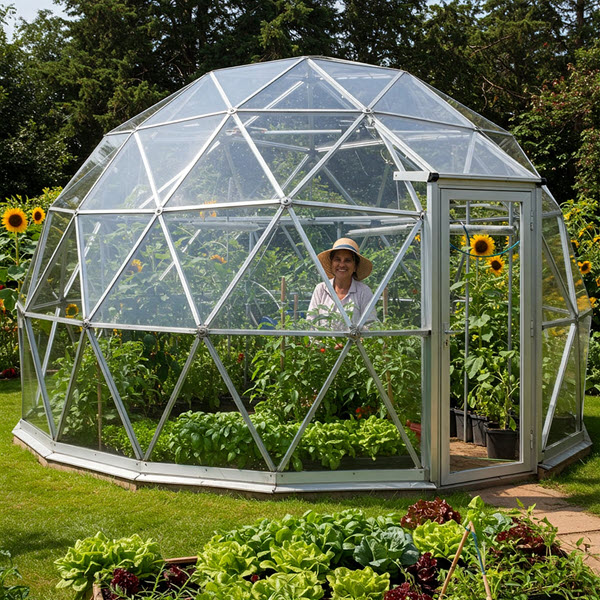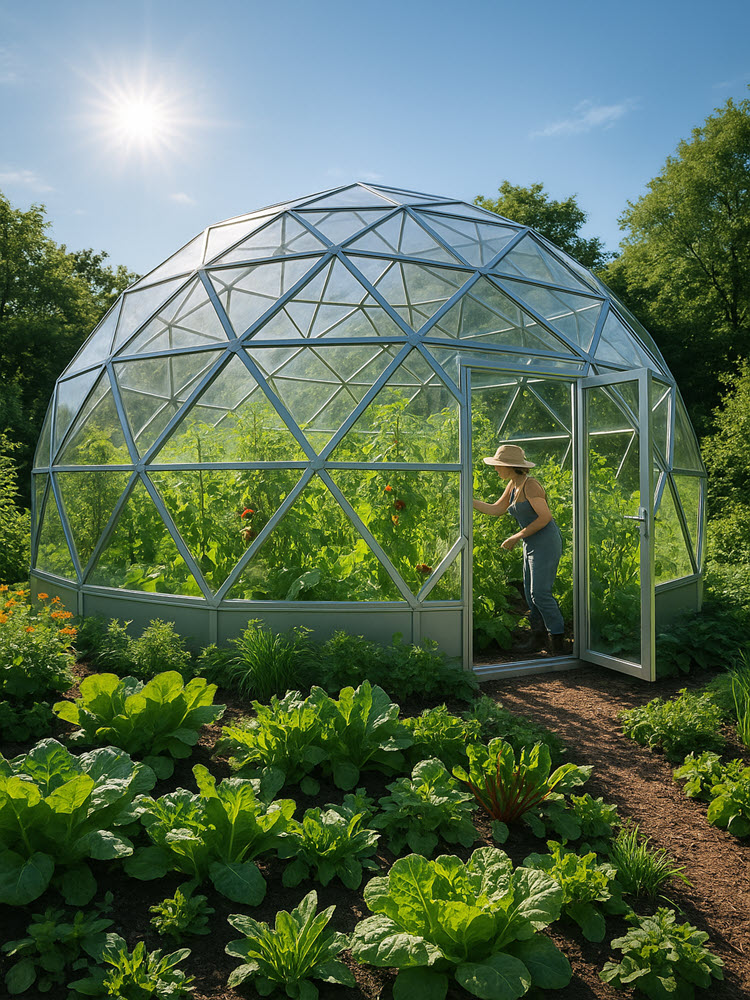
The Smart Way to Grow All Year Round
Geodesic Dome Greenhouses
| Material | Pros | Cons |
| Wood | Great look, warm | Needs upkeep |
| Steel | Super strong | Heavy, pricey |
| PVC | Light, cheap | Not long-lasting |
What’s a Geodesic Dome Greenhouse, Anyway?
- Definition: A geodesic dome greenhouse is a round structure made up of a bunch of interconnected triangles. Sounds a bit math-y, but all you need to know is that this shape is crazy strong and efficient.
- Origin: Buckminster Fuller, the inventor of the design, created it to be both practical and beautiful.
- Why the shape works: The dome’s shape helps spread weight evenly, which makes it incredibly stable, and that curved surface lets sunlight in from every direction. That’s a big win for your plants.
Why Go for a Geodesic Dome Greenhouse?
- Energy efficiency: These domes hold heat like a champ and let in sunlight from all angles, so you can cut back on artificial lights and heating. That curved shape? It’s not just for looks—it helps trap warm air, especially during chilly nights.
- Structural strength: Those triangles work together to make the whole thing tough as nails. It can stand up to wind, snow, and whatever else the weather throws at it.
- Space optimization: You get a lot of space inside, thanks to the dome’s design. The layout naturally encourages vertical growing, which means more plants per square foot.
- Natural airflow: The dome’s shape helps air circulate better, which cuts down on mold and mildew. Add in a few vents, and you’ve got a self-regulating, super-healthy environment for your plants.
Planning and Building Your Dome
- Choosing the location: You’ll want a spot that gets plenty of sun, ideally facing south. Make sure the ground is level, drains well, and is close to water and electricity if you plan to use heaters or fans.
Frame materials:
- Wood: Looks great and insulates well, but it needs upkeep.
- Galvanized steel: Super durable and low-maintenance, but it’s heavier and more expensive.
- PVC: Lightweight and budget-friendly, though it’s not as tough in the long run.
- Covering materials:
- Polycarbonate panels: Strong, UV-resistant, and provide excellent insulation.
- Polyethylene film: Affordable and easy to work with but needs replacing every few years.
- Glass: Visually appealing and durable but heavy and fragile.
- Foundation options: Some people go with a concrete slab, while others use gravel or pressure-treated wood. Just make sure it’s solid, level, and suited to your local climate.
- Ventilation and climate control: Add in roof vents, side vents, or even automated fans. Some folks go all out with sensors and smart climate control systems.
What Can You Grow Inside?
- Leafy greens and herbs: Lettuce, kale, spinach, basil, and cilantro are fast growers and thrive in the dome’s stable environment.
- Fruits and vegetables: Tomatoes, strawberries, cucumbers, and peppers do well too, especially if you create warmer zones inside the dome.
- Tropical and exotic plants: You can grow bananas, pineapples, and even orchids with a little added heating.
- Microgreens and sprouts: These are perfect for small spaces and quick harvests—ideal if you’re using vertical shelves or tiered systems.
DIY vs. Buying a Kit
- Going the DIY route: If you’re handy and love a challenge, building your own dome can be a fun, rewarding project. You’ll save money and get a custom setup, but it takes time and effort.
- Buying a prefab kit: Kits come with everything you need and are a great option if you want to get growing quickly. You’ll spend more upfront, but it’s way faster and easier to set up.
- Added features in kits: Many kits offer extras like automatic vents, solar-powered fans, and built-in shelving—perfect for beginners or busy growers.
Go Green With Your Dome
- Water conservation: Install gutters around the dome to collect rainwater and use it for irrigation.
- Energy efficiency: Add solar panels for power, and use thermal mass like water barrels or stone floors to trap heat.
- Sustainable gardening: Domes are great for composting, organic gardening, and using companion planting techniques that support eco-friendly growth.
Common Issues and Easy Fixes
- Condensation problems: Domes can get foggy inside, especially in cold weather. Make sure you have good ventilation, maybe even a dehumidifier, to keep moisture in check.
- Complex builds: DIY domes can get tricky with all those triangles and angles. Use pre-made connectors or kits to make things easier.
- Pest control: While domes are pretty sealed up, pests still find their way in. Use sticky traps, physical barriers, or natural pest-repelling plants to keep them away.
- Maintenance tips: Keep an eye on seals and joints, clean the dome panels to maximize light, and do regular checkups on the structure—especially after storms or rough weather.
Is a Geodesic Dome Greenhouse Right for You?
- Budget considerations: Domes can cost more upfront, especially with quality materials, but the energy savings and durability pay off over time.
- Climate compatibility: If you live in an area with heavy snow, strong winds, or temperature swings, a dome’s strength and insulation make it a great choice.
- Gardening goals: Whether you’re growing for fun, food, or even tropical plants, domes support a wide range of growing environments.
- Space availability: Make sure your yard or property can handle the footprint and height of the dome you want.
Top Recommendations for Geodesic Dome Greenhouses
No 1: Geodesic Dome Greenhouse
No 2: Geodesic Dome Greenhouse
No 3: Geodesic Dome Greenhouse
No 4: Geodesic Dome Greenhouse
Conclusion
Geodesic dome greenhouses aren’t just trendy—they’re incredibly practical and smart. With unbeatable strength, natural energy efficiency, and plenty of space, these domes are a solid investment for any gardener who wants to take things to the next level. Whether you’re just starting out or looking to upgrade your setup, a dome greenhouse gives you flexibility, protection, and the perfect environment to grow year-round.
Key Takeaway: A geodesic dome greenhouse offers strong, weather-resistant design, excellent energy efficiency, and an ideal growing environment—perfect for gardeners looking to grow smarter, not harder.
FAQs
Can I install a geodesic dome greenhouse on uneven terrain?
It’s best to level the ground or build a solid foundation. That ensures the structure stays stable and drains properly.
What is the ideal diameter for a backyard geodesic dome greenhouse?
Most backyard domes range from 16 to 26 feet across. That gives you good growing space without taking over your yard.
Do I need a building permit for a geodesic dome greenhouse?
Depends on where you live. Always check with your local building department to see if permits are needed before you start building.
Can I use a geodesic dome greenhouse off-grid?
Absolutely. You can add solar panels, collect rainwater, and even use compost heating to go fully off-grid.
How do I regulate temperature in extreme climates?
Use thermal mass (like water barrels), proper insulation, and automated vents or fans. These help maintain a steady internal climate year-round.








